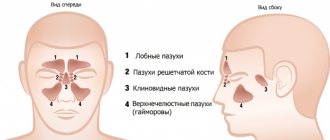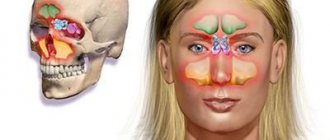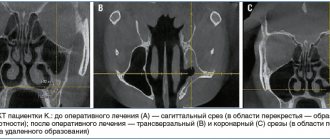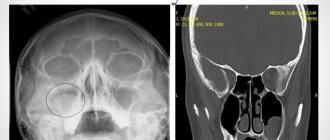Inflammation of the maxillary sinuses is not the most dangerous disease today. The large number of effective antibiotics makes treatment of this disease relatively simple. However, if left untreated, sinusitis can cause serious complications. It is known that everything in the human body is interconnected. The source of infection and inflammation in the nasopharynx can spread to other parts of the head. The most dangerous are meningitis and cerebral edema.
Sinusitis can be acute or chronic. The acute form of sinusitis most often occurs due to infection entering the nasopharynx. The causes of this disease are viruses, bacteria or fungi. Most often, sinusitis occurs against the background of a viral infection. Inflammation of the maxillary sinuses caused by a fungal infection is difficult to treat.
In addition, inflammation of the paranasal sinuses can occur as a result of its injuries, which can lead to disruption of the anatomical structure of the bone walls of the nasal cavity and sinuses. Also, sinusitis often appears after a long allergic rhinitis.
Chronic sinusitis occurs in the absence of proper and timely treatment of the acute form of the disease. Treatment of chronic sinusitis requires much more time and effort. Therefore, it is better not to bring your body to such a state.
Main symptoms of sinusitis
The main and most well-known symptom of inflammation of the maxillary sinuses is headache. In some cases, pain can cause a lot of inconvenience; in rare cases, the pain reaches such heights that it is necessary to take painkillers. At the beginning of the disease it has a certain localization. With sinusitis, discomfort occurs in the forehead, nose and around the eyes. However, after some time the pain becomes irritating, affecting many areas of the head.
The pain of sinusitis can sometimes be very similar to the pain of a migraine. However, sinusitis also has other symptoms, which, coupled with headaches, allow the doctor to diagnose this disease quite accurately. To confirm the diagnosis, radiography of the paranasal sinuses is used.
On x-rays with sinusitis, shadows are clearly visible, in which you can guess the fluid accumulated in the maxillary sinuses of the nose. This liquid is a mixture of mucus and pus. It is the accumulation of exudate in the maxillary sinuses that is responsible for the appearance of headaches, as it puts pressure on the inflamed mucous membrane and causes discomfort.
Headache with this disease can intensify when bending the body forward, as well as from sudden movements of the head. To minimize discomfort, the patient needs rest. There are also other symptoms of inflammation of the maxillary sinuses:
- nasal discharge;
- nasal congestion;
- swelling of the soft tissues of the face, eyelids;
- increased body temperature;
- weakness, irritability.
These symptoms are characteristic not only of sinusitis, but coupled with a severe headache, they indicate precisely this disease. If you suspect an inflammatory process in the maxillary sinuses, you should immediately consult a doctor and undergo an examination to confirm the diagnosis. Untreated sinusitis can have serious consequences for the body.
Angiofibroma
Benign vascular space-occupying lesion with slowly aggressive growth; localized in the nasal cavity; grows around the posterior wall of the nasal cavity, along the edges of the pterygopalatine foramen; in the early stages penetrates into the pterygopalatine fossa (arrows), grows into the medial pterygoid plate
a rare, but benign tumor characteristic of the nasal cavity and its sinuses. More common in men. As a rule, it occurs on the side wall of the nasal cavity, as well as in the paranasal sinuses. From the nasal cavity, a tumor can grow into the paranasal sinus and vice versa. Patients usually complain of nasal congestion, discharge, nosebleeds, and pain in the facial nerve area. Sometimes bone tissue is destroyed in the area of tumor growth.
Transitional cell papilloma with bone wall remodeling
A formation in the center of the middle nasal meatus, accumulating a contrast agent, spreads into the maxillary sinus and/or cells of the ethmoid bone labyrinth
Features of radiography for sinusitis
The main way to confirm sinusitis today is still radiography. The procedure takes very little time and is available in most clinics in Russia.
On an x-ray of the paranasal sinuses with sinusitis, darkening in the area of the maxillary sinuses is clearly visible, indicating that there is an inflammatory process and there is excess fluid. Depending on the severity of the disease, the darkening can be local (small), subtotal and total.
Small darkening indicates that the disease began not long ago, the painful manifestations are not very pronounced, and drug treatment will be most effective.
Subtotal blackout
Subtotal darkening of the maxillary sinuses may indicate a severe inflammatory process. This suggests that the disease is in an advanced state. In such cases, in addition to antibacterial therapy, procedures may be prescribed to remove fluid from the inflamed sinus cavity.
Sometimes the inflammation spreads to other paranasal sinuses. Sinusitis can turn into frontal sinusitis or sinusitis. In such cases, the pathological process affects, respectively, the frontal sinuses or the ethmoid labyrinth.
Total blackout
Detection of total darkening on an x-ray is an alarming sign. However, modern medicine copes with such advanced cases. The most important thing is that treatment is started immediately.
If the sinuses are filled with pus and inflammatory processes are in full swing, then doctors prescribe fairly high doses of antibiotics to prevent the development of serious complications. Additionally, a puncture of the maxillary sinuses can be performed to remove accumulated exudate.
On the issue of diagnosis and treatment of sinusitis
Having studied the above article by our English colleagues on the diagnosis and treatment of sinusitis, we decided to present our own view on this problem.
Acute and chronic sinusitis is a common pathology in both adults and children.
In Russia, unlike the UK, the treatment of sinusitis is not yet carried out by general practitioners or local therapists; this pathology still remains under the jurisdiction of otolaryngologists. But, of course, initially it is the therapist or pediatrician who meets with these patients, who should suspect that we are not talking about ARVI, accompanied by catarrhal symptoms, or rhinitis, but about sinusitis. This is especially important in an acute process, since with chronic sinusitis, patients, as a rule, are well aware of their diagnosis and are observed by an ENT doctor.
In the process of diagnosing and differential diagnosis of sinusitis, we consider it advisable to conduct an ultrasound examination of the paranasal sinuses (SNS) as a screening test, which can answer the question: are there pathological changes in the SNS or not? If no pathology is found, you need to continue the diagnostic search in another direction: ARVI, adenoiditis, nasopharyngitis; This is especially true for children.
If pathology is detected during ultrasound diagnostics, we recommend that an X-ray of the PPN be performed.
| Figure 1. X-ray of the PPN: total darkening of the right maxillary sinus |
Unlike our English colleagues, we believe that planar radiography of PPN, despite its nonspecificity, is quite informative. In Fig. 1-3 show radiographs of the PPN, from which it is quite clear to draw a conclusion about the pathological process in the sinuses. On the first radiograph (Fig. 1) we see a total darkening of the right maxillary sinus and slight veiling of the cells of the ethmoidal labyrinth and frontal sinus, which, with an appropriate history, may indicate acute right-sided hemisinusitis. On the second (Fig. 2) there is a darkening of both maxillary sinuses, which suggests acute bilateral sinusitis (puncture in this case resulted in pus). On the third radiograph (Fig. 3) there is a level in the left maxillary sinus (liquid pus was obtained during aspiration during puncture), which also indicates left-sided acute purulent sinusitis.
Computed tomography, of course, is a more accurate diagnostic method, but given the high radiation exposure and high cost of the study, it should be used only if a tumor in the sinus is suspected or there is any uncertainty in the diagnosis.
| Figure 2. X-ray of the PPN: total darkening of both maxillary sinuses |
In addition, if a purulent form of acute or exacerbation of chronic sinusitis (sinusroethmoiditis) is suspected, therapeutic and diagnostic puncture of the maxillary sinus is one of the most effective diagnostic and therapeutic measures.
Classic puncture of the maxillary sinuses using a Kulikovsky needle allows, firstly, to accurately determine the nature of the contents in the sinus (mucus, pus, blood); secondly, to obtain a reliable bacteriological study of the microflora of the maxillary sinus (without impurities of discharge from the nasal cavity and adenoids, sputum), which is currently extremely important due to the increased resistance of microorganisms, and to conduct a cytological study if necessary; finally, this procedure, purely mechanically, allows you to remove pathological contents from the sinus and treat the mucous membrane with various medications, depending on the nature of the process (antiseptics, antibiotics, corticosteroids, proteolytic enzymes, oxygen, etc.).
| Figure 3. Radiographs of the PPN: darkening in the left maxillary sinus (level) |
To perform a puncture of the maxillary sinus, an X-ray of the PPN is also absolutely necessary, not only to clarify the diagnosis, but also to orientate in the individual characteristics of the sinus geometry.
The question of possible treatment options for acute and exacerbation of chronic sinusitis is also very relevant. We believe that in the presence of purulent contents in the sinus and symptoms of intoxication, it is necessary to use antibacterial drugs taking into account bacteriological examination. If the doctor believes that the patient needs urgent antibiotic therapy, then, based on the fact that acute sinusitis is most often caused by Streptococculs pneulmoniae, Heamophiluls influlenzae and Moraxella catarralis, it makes sense to prescribe second-generation cephalosporins or broad-spectrum antibiotics, such as amoxicillin, which is effective accumulates also in bone tissue. Of all the dosage forms of amoxicillin, Flemoxin Solutab (manufactured in Holland) is preferable, the bioavailability of which is 93%. Almost complete absorption in the intestine ensures high efficiency (equivalent to intramuscular injections) and reduces the risk of developing dysbiosis. In addition, Flemoxin Solutab tablets are very convenient for small patients to take, as they have a pleasant smell and taste, and can be dissolved in water.
If the patient has mucous discharge from the sinus in satisfactory condition, you can try to manage the patient without antibiotics, but with the use of complex homeopathic medicines that relieve swelling of the mucous membrane, such as cinnabsin.
The attitude towards nasal steroids should be very careful. During exacerbation of the purulent form of chronic sinusitis, the administration of glucocorticoids is hardly justified, and is often contraindicated. In addition, it is known that excessive use of local glucocorticoid drugs contributes to the development of mycotic infections, which are common in our time and difficult to treat.
And lastly: we believe that if any pathology in the PPN, banal sinusitis or neoplastic process is suspected, the patient should be referred to an otolaryngologist, and not tried to be treated in a therapeutic practice.
Possible complications of advanced sinusitis
Sinusitis in itself is not a dangerous disease. However, inflammation in tissues so close to the brain can have serious consequences, especially if not treated adequately and promptly.
Meningitis and meningoencephalitis
Meningitis is a dangerous disease characterized by an inflammatory process in the membranes of the brain. This disease can lead to disability and even death.
Meningoencephalitis is an even more serious disease. Inflammation in meningoencephalitis covers both the membranes and the substance of the brain.
The symptoms of these diseases are similar:
- headache;
- nausea;
- vomit;
- chills;
- elevated body temperature.
These diseases are very insidious. If there are prerequisites for their occurrence, they can develop in an acute form within just a few hours.
Both diseases are extremely dangerous and have a poor prognosis. High probability of death.
Chronic sinusitis
If acute sinusitis is treated incorrectly or not treated at all, the disease may become chronic. Chronic sinusitis is difficult to treat, and it is impossible to guarantee a positive treatment outcome.
Periodically, with a decrease in immunity, chronic sinusitis will worsen, causing a lot of inconvenience. In addition, a chronic inflammatory process in the maxillary sinuses is fraught with much more serious problems, including:
- chronic rhinitis;
- inflammation of bone tissue;
- inflammation of brain tissue.
You should take care of your health. Then the occurrence of a disease such as chronic sinusitis is unlikely.
Treatment of advanced sinusitis
After developing radiographs, one can judge the severity of the inflammatory process occurring in the maxillary sinuses. In case of total blackout, the doctor may prescribe a shock course of antibiotics and antihistamines to suppress inflammatory processes and reduce the severity of some symptoms.
In the most severe cases, surgical intervention may be indicated - puncture of the sinuses. This procedure has been known for a long time and is widely used in many countries around the world. Using a special syringe, excess fluid and pus are pumped out of the maxillary sinus. Then the sinus is filled with a special solution containing antiseptic drugs. This is done to reduce inflammation of the mucous membrane. Then the solution is pumped out of the sinuses. That's it, the procedure is completed.
This type of surgery is not dangerous, but it can speed up recovery and reduce the appearance of major symptoms, such as headaches.
For more effective treatment of sinusitis, the pus obtained after puncture can be sent for culture to identify the pathogen and determine which antibacterial drugs it is most sensitive to. Along with antibiotics, antihistamines are often prescribed to help reduce swelling, nasal congestion and other manifestations of the disease.
Some traditional medicines can be used to treat sinusitis. Such remedies should not replace the primary treatment prescribed by a doctor. They can only complement it. Moreover, before using any means, you should consult your doctor.
Using exclusively traditional medicine to treat sinusitis can lead to disastrous results. Untreated sinusitis will become chronic and will periodically trouble the patient throughout his life.
Total blackout
Total darkening is characteristic of inflammatory diseases of the sinuses, in which exudate of a different nature is produced: mucus, pus, serous fluid. In this case, the sinus is not filled completely, but only half or 2/3 of the total area of the cavity.
If the patient's fluid production is a consequence of a hypersensitivity reaction, then the picture shows formations of the mucous membrane in the form of pads. In radiology, this sign is called “plus shadow”, in which darkening of varying degrees of intensity is observed.
In the image, fluid, pus and changes in the structure of the epithelium may appear in the same color. In this case, to clarify the diagnosis, additional examination methods are prescribed - laboratory, endoscopic, instrumental (CT, ultrasound).
If homogeneous darkening appears more on the right, one should assume edema, on the left - accumulation of pus.
The harm of self-medication
The most obvious harm of self-medication is the lack of positive results. People often take medications until they feel better. However, this approach is wrong. Antibacterial drugs should be taken only as prescribed by a doctor. Strictly in the volumes and within the time frame that he announced at the reception. Otherwise, the symptoms will go away, but the source of infection will remain. Inflammation in the maxillary sinus will become chronic.
Or, if the drugs were chosen incorrectly, there may be no improvement at all. The disease will become advanced, the pain due to overcrowded sinuses will become unbearable, and inflammation will have a chance to spread to the organs and tissues closest to the sinuses, causing all sorts of complications.
Another risk of self-medication is the medications that must be taken for sinusitis. If the dosage is incorrect, taken too often, or if there are problems with internal organs, antibacterial drugs can do more harm than good. Cases of drug-induced liver damage from uncontrolled use of antibiotics are not so rare. What can we say about gastrointestinal tract disorders, dysbacteriosis, and so on.
Treatment
In case of severe or total damage to the sinuses or one sinus, radical surgical intervention is indicated.
Rinsing of the paranasal sinuses using the fluid movement method (“Cuckoo”) or puncture of the maxillary sinus with quinosole, systemic use of amphotericin B or ketoconazole and intraconazole (antifungal antibacterial drugs) are prescribed. Chronic inflammation of the paranasal sinuses is based on changes in the immune system, so treatment should be treated with drugs that help restore it. It is effective to use polyoxidonium in the form of rectal suppositories, a course of 10 times every other day, before bedtime. Antibacterial therapy is also needed. Preference is still given to protected penicillins. Desensitizing and local therapy is also required, which is discussed individually at an appointment with an ENT doctor.











